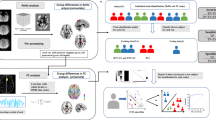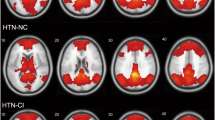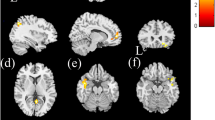Abstract
Purpose
To investigate the alterations of topological organization of the whole brain functional networks in hypertension patients with cognitive impairment (HTN-CI) and characterize its relationship with cognitive scores.
Methods
Fifty-seven hypertension patients with cognitive impairment and 59 hypertension patients with normal cognition (HTN-NC), and 49 healthy controls (HCs) underwent resting-state functional magnetic resonance imaging. Graph theoretical analysis was used to investigate the altered topological organization of the functional brain networks. The global topological properties and nodal metrics were compared among the three groups. Network-based statistic (NBS) analysis was used to determine the connected subnetwork. The relationships between network metrics and cognitive scores were also characterized.
Results
HTN-CI patients exhibited significantly decreased global efficiency, lambda, and increased shortest path length when compared with HCs. In addition, both HTN-CI and HTN-NC groups exhibited altered nodal degree centrality and nodal efficiency in the right precentral gyrus. The disruptions of global network metrics (lambda, Lp) and the nodal metrics (degree centrality and nodal efficiency) in the right precentral gyrus were positively correlated with the MoCA scores in HTN-CI. NBS analysis demonstrated that decreased subnetwork connectivity was present both in the HTN-CI and HTN-NC groups, which were mainly involved in the default mode network, frontoparietal network, and cingulo-opercular network.
Conclusion
This study demonstrated the alterations of topographical organization and subnetwork connectivity of functional brain networks in HTN-CI. In addition, the global and nodal network properties were correlated with cognitive scores, which may provide useful insights for the understanding of neuropsychological mechanisms underlying HTN-CI.






Similar content being viewed by others
Data availability
The datasets used or analysed during the current study are included in this published article.
Code or software availability
MATLAB 2013b (The Mathworks, Natick, MA, USA), Statistical Parametric Mapping, version 12 (SPM12, http://www.fil.ion.ucl.ac.uk/spm), and DPABI (http://rfmri.org/dparbi) software were used for resting-state image pre-processing. The functional connection matrix was constructed (including nodes and edges) by using the graph theoretical network analysis toolbox (GRETNA, http://www.nitrc.org/projects/gretna). NBS toolbox (https://www.nitrc.org/projects/nbs) was used for the subnetwork connectivity analysis.
References
Poulter NR, Prabhakaran D, Caulfield M (2015) Hypertension. Lancet (London, England) 386(9995):801–812. https://doi.org/10.1016/s0140-6736(14)61468-9
Jia L, Du Y, Chu L, Zhang Z, Li F, Lyu D et al (2020) Prevalence, risk factors, and management of dementia and mild cognitive impairment in adults aged 60 years or older in China: a cross-sectional study. The Lancet Public health 5(12):e661–e671. https://doi.org/10.1016/s2468-2667(20)30185-7
Iadecola C, Yaffe K, Biller J, Bratzke LC, Faraci FM, Gorelick PB et al (2016) Impact of hypertension on cognitive function: a scientific statement from the American Heart Association. Hypertension 68(6):e67–e94. https://doi.org/10.1161/HYP.0000000000000053
Pavlovic AM, Pekmezovic T, Trajkovic JZ, Tomic G, Cvitan E, Sternic N (2018) Increased risk of cognitive impairment and more severe brain lesions in hypertensive compared to non-hypertensive patients with cerebral small vessel disease. J Clin Hypertens (Greenwich) 20(9):1260–1265. https://doi.org/10.1111/jch.13357
Shah C, Srinivasan D, Erus G, Schmitt JE, Agarwal A, Cho ME et al (2021) Changes in brain functional connectivity and cognition related to white matter lesion burden in hypertensive patients from SPRINT. Neuroradiology 63(6):913–924. https://doi.org/10.1007/s00234-020-02614-6
Gu Y, Liu R, Qin R, Chen X, Zou J, Jiang Y et al (2019) Characteristic changes in the default mode network in hypertensive patients with cognitive impairment. Hypertens Res 42(4):530–540. https://doi.org/10.1038/s41440-018-0176-4
Kurosaki H, Nakahata K, Donishi T, Shiro M, Ino K, Terada M et al (2018) Effects of perinatal blood pressure on maternal brain functional connectivity. PLoS ONE 13(8):e0203067. https://doi.org/10.1371/journal.pone.0203067
Xiong Y, Tian T, Fan Y, Yang S, Xiong X, Zhang Q et al (2022) Diffusion tensor imaging reveals altered topological efficiency of structural networks in type-2 diabetes patients with and without mild cognitive impairment. J Magn Reson Imaging 55(3):917–927. https://doi.org/10.1002/jmri.27884
Zhu H, Zuo L, Zhu W, Jing J, Zhang Z, Ding L et al (2022) The distinct disrupted plasticity in structural and functional network in mild stroke with basal ganglia region infarcts. Brain Imaging Behav. https://doi.org/10.1007/s11682-022-00689-8
Zhou B, Wang X, Yang Q, Wu F, Tang L, Wang J et al (2022) Topological alterations of the brain functional network in type 2 diabetes mellitus patients with and without mild cognitive impairment. Front Aging Neurosci 14:834319. https://doi.org/10.3389/fnagi.2022.834319
Wu Y, Zhong Y, Zheng G, Liu Y, Pang M, Xu H et al (2022) Disrupted fronto-temporal function in panic disorder: a resting-state connectome study. Brain Imaging Behav 16(2):888–898. https://doi.org/10.1007/s11682-021-00563-z
Mentzelopoulos A, Karanasiou I, Papathanasiou M, Kelekis N, Kouloulias V, Matsopoulos GK (2022) A comparative analysis of white matter structural networks on SCLC patients after chemotherapy. Brain Topogr 35(3):352–362. https://doi.org/10.1007/s10548-022-00892-2
Chu T, Li Y, Che K, Dong F, Ma H, Shi Y et al (2022) Pregnancy leads to changes in the brain functional network: a connectome analysis. Brain Imaging Behav 16(2):811–819. https://doi.org/10.1007/s11682-021-00561-1
Zhang T, Liao Q, Zhang D, Zhang C, Yan J, Ngetich R et al (2021) Predicting MCI to AD conversation using integrated sMRI and rs-fMRI: machine learning and graph theory approach. Front Aging Neurosci 13:688926. https://doi.org/10.3389/fnagi.2021.688926
Suo X, Lei D, Li N, Li J, Peng J, Li W et al (2021) Topologically convergent and divergent morphological gray matter networks in early-stage Parkinson’s disease with and without mild cognitive impairment. Hum Brain Mapp 42(15):5101–5112. https://doi.org/10.1002/hbm.25606
Zhou HY, Shi LJ, Shen YM, Fang YM, He YQ, Li HB et al (2021) Altered topographical organization of grey matter structural network in early-onset schizophrenia. Psychiatry Res Neuroimaging 316:111344. https://doi.org/10.1016/j.pscychresns.2021.111344
Yang F, Ma H, Yuan J, Wei Y, Xu L, Zhang Y et al (2021) Correlation of abnormalities in resting state fMRI with executive functioning in chronic schizophrenia. Psychiatry Res 299:113862. https://doi.org/10.1016/j.psychres.2021.113862
Yang H, Chen X, Chen ZB, Li L, Li XY, Castellanos FX et al (2021) Disrupted intrinsic functional brain topology in patients with major depressive disorder. Mol Psychiatry 26(12):7363–7371. https://doi.org/10.1038/s41380-021-01247-2
Carnevale L, Maffei A, Landolfi A, Grillea G, Carnevale D, Lembo G (2020) Brain functional magnetic resonance imaging highlights altered connections and functional networks in patients with hypertension. Hypertension 76(5):1480–1490. https://doi.org/10.1161/HYPERTENSIONAHA.120.15296
Xin H, Wen H, Feng M, Gao Y, Sui C, Zhang N et al (2022) Disrupted topological organization of resting-state functional brain networks in cerebral small vessel disease. Hum Brain Mapp 43(8):2607–2620. https://doi.org/10.1002/hbm.25808
Li X, Liang Y, Chen Y, Zhang J, Wei D, Chen K et al (2015) Disrupted frontoparietal network mediates white matter structure dysfunction associated with cognitive decline in hypertension patients. J Neurosci 35(27):10015–10024. https://doi.org/10.1523/JNEUROSCI.5113-14.2015
Li Y, Chu T, Che K, Dong F, Shi Y, Ma H et al (2021) Altered gray matter structural covariance networks in postpartum depression: a graph theoretical analysis. J Affect Disord 293:159–167. https://doi.org/10.1016/j.jad.2021.05.018
Tsai JD, Ho MC, Lee HY, Shen CY, Li JY, Weng JC (2021) Disrupted white matter connectivity and organization of brain structural connectomes in tuberous sclerosis complex patients with neuropsychiatric disorders using diffusion tensor imaging. MAGMA 34(2):189–200. https://doi.org/10.1007/s10334-020-00870-4
Feng M, Zhang Y, Liu Y, Wu Z, Song Z, Ma M et al (2021) White matter structural network analysis to differentiate Alzheimer’s disease and subcortical ischemic vascular dementia. Front Aging Neurosci 13:650377. https://doi.org/10.3389/fnagi.2021.650377
Mancia G, De Backer G, Dominiczak A, Cifkova R, Fagard R, Germano G et al (2007) 2007 guidelines for the management of arterial hypertension: the Task Force for the Management of Arterial Hypertension of the European Society of Hypertension (ESH) and of the European Society of Cardiology (ESC). Eur Heart J 28(12):1462–1536. https://doi.org/10.1093/eurheartj/ehm236
Petersen RC (2004) Mild cognitive impairment as a diagnostic entity. J Intern Med 256(3):183–194. https://doi.org/10.1111/j.1365-2796.2004.01388.x
Yan CG, Wang XD, Zuo XN, Zang YF (2016) DPABI: data processing & analysis for (resting-state) brain imaging. Neuroinformatics 14(3):339–351. https://doi.org/10.1007/s12021-016-9299-4
Wang J, Wang X, Xia M, Liao X, Evans A, He Y (2015) GRETNA: a graph theoretical network analysis toolbox for imaging connectomics. Front Hum Neurosci 9:386. https://doi.org/10.3389/fnhum.2015.00386
Jain P, Sao AK, Minhas AS (2021) Analyzing the effect of resolution of network nodes on the resting state functional connectivity maps of schizophrenic human brains. Annual International Conference of the IEEE Engineering in Medicine and Biology Society IEEE Engineering in Medicine and Biology Society Annual International Conference 2021:6695–6698. https://doi.org/10.1109/embc46164.2021.9630822
Chen X, Chen L, Zheng S, Wang H, Dai Y, Chen Z et al (2021) Disrupted brain connectivity networks in aphasia revealed by resting-state fMRI. Front Aging Neurosci 13:666301. https://doi.org/10.3389/fnagi.2021.666301
Power JD, Cohen AL, Nelson SM, Wig GS, Barnes KA, Church JA et al (2011) Functional network organization of the human brain. Neuron 72(4):665–678. https://doi.org/10.1016/j.neuron.2011.09.006
Zhou C, Guo T, Bai X, Wu J, Gao T, Guan X et al (2021) Locus coeruleus degeneration is associated with disorganized functional topology in Parkinson’s disease. Neuroimage Clin 32:102873. https://doi.org/10.1016/j.nicl.2021.102873
Liu X, He C, Fan D, Zang F, Zhu Y, Zhang H et al (2021) Alterations of core structural network connectome associated with suicidal ideation in major depressive disorder patients. Transl Psychiatry 11(1):243. https://doi.org/10.1038/s41398-021-01353-3
Li X, Yang C, Xie P, Han Y, Su R, Li Z et al (2021) The diagnosis of amnestic mild cognitive impairment by combining the characteristics of brain functional network and support vector machine classifier. J Neurosci Methods 363:109334. https://doi.org/10.1016/j.jneumeth.2021.109334
Li W, Zhao H, Qing Z, Nedelska Z, Wu S, Lu J et al (2021) Disrupted network topology contributed to spatial navigation impairment in patients with mild cognitive impairment. Front Aging Neurosci 13:630677. https://doi.org/10.3389/fnagi.2021.630677
Jiang Y, Gao Y, Dong D, Sun X, Situ W, Yao S (2021) Impaired global efficiency in boys with conduct disorder and high callous unemotional traits. J Psychiatr Res 138:560–568. https://doi.org/10.1016/j.jpsychires.2021.04.041
Ji C, Zhou Q, Qiu Y, Pan X, Sun X, Ding W et al (2021) Decline of anterior cingulate functional network efficiency in first-episode, medication-naive somatic symptom disorder and its relationship with catastrophizing. J Psychiatr Res 140:468–473. https://doi.org/10.1016/j.jpsychires.2021.06.019
Tillem S, Harenski K, Harenski C, Decety J, Kosson D, Kiehl KA et al (2019) Psychopathy is associated with shifts in the organization of neural networks in a large incarcerated male sample. Neuroimage Clin 24:102083. https://doi.org/10.1016/j.nicl.2019.102083
Wang W, Mei M, Gao Y, Huang B, Qiu Y, Zhang Y et al (2020) Changes of brain structural network connection in Parkinson’s disease patients with mild cognitive dysfunction: a study based on diffusion tensor imaging. J Neurol 267(4):933–943. https://doi.org/10.1007/s00415-019-09645-x
Zhang Z, Cui L, Huang Y, Chen Y, Li Y, Guo Q (2021) Changes of regional neural activity homogeneity in preclinical Alzheimer’s disease: compensation and dysfunction. Front Neurosci 15:646414. https://doi.org/10.3389/fnins.2021.646414
Wang Y, Jiang M, Huang L, Meng X, Li S, Pang X et al (2021) Altered functional brain network in systemic lupus erythematosus patients without overt neuropsychiatric symptoms based on resting-state functional magnetic resonance imaging and multivariate pattern analysis. Front Neurol 12:690979. https://doi.org/10.3389/fneur.2021.690979
Wang X, Hu T, Yang Q, Jiao D, Yan Y, Liu L (2021) Graph-theory based degree centrality combined with machine learning algorithms can predict response to treatment with antiepileptic medications in children with epilepsy. Journal of clinical neuroscience : official journal of the Neurosurgical Society of Australasia 91:276–282. https://doi.org/10.1016/j.jocn.2021.07.016
Kim D, Lee S, Choi M, Youn H, Suh S, Jeong HG et al (2019) Diffusion tensor imaging reveals abnormal brain networks in elderly subjects with subjective cognitive deficits. Neurol Sci 40(11):2333–2342. https://doi.org/10.1007/s10072-019-03981-6
Wang Y, Yin X, Zhang Z, Li J, Zhao W, Guo ZV (2021) A cortico-basal ganglia-thalamo-cortical channel underlying short-term memory. Neuron 109(21):3486-3499.e3487. https://doi.org/10.1016/j.neuron.2021.08.002
Zuo M, Xu Y, Zhang X, Li M, Jia X, Niu J et al (2018) Aberrant brain regional homogeneity and functional connectivity of entorhinal cortex in vascular mild cognitive impairment: a resting-state functional MRI study. Front Neurol 9:1177. https://doi.org/10.3389/fneur.2018.01177
Bu L, Huo C, Xu G, Liu Y, Li Z, Fan Y et al (2018) Alteration in brain functional and effective connectivity in subjects with hypertension. Front Physiol 9:669. https://doi.org/10.3389/fphys.2018.00669
Wang Y, Li S, Pan Y, Wang M, Liao X, Shi J et al (2021) The effects of blood pressure on post stroke cognitive impairment BP and PSCI. J Clin Hypertens (Greenwich). https://doi.org/10.1111/jch.14373
Pepin M, Ferreira AC, Arici M, Bachman M, Barbieri M, Bumblyte IA et al (2021) Cognitive disorders in patients with chronic kidney disease: specificities of clinical assessment. Nephrol Dial Transplant. https://doi.org/10.1093/ndt/gfab262
Acknowledgements
We would like to thank all the patients and healthy controls who joined in the present study.
Funding
None.
Author information
Authors and Affiliations
Contributions
All authors contributed to the study’s conception and design. Chun-Hong Liu contributed to the conception of the study; Dan Liao and Zhi-Peng Guo performed the experiment; Dan Liao and Zhu-Qing Zhang contributed significantly to the analysis and manuscript preparation; Ming-Hao Yang performed the data analyses and wrote the manuscript; Xin-Feng Liu helped perform the analysis with constructive discussions. All authors read and approved the final manuscript.
Corresponding authors
Ethics declarations
Conflict of interest statement
The authors declare that there is no potential conflict of interests regarding the publication of this paper.
Ethics approval
This study received approval from the Medical Ethics Committee of Beijing Anding Hospital, Capital Medical University, and this study was performed in line with the principles of the Declaration of Helsinki.
Consent to participate
Written informed consent was obtained from all participants before the experiment.
Consent for publication
The participants have consented to the submission of the original research to the journal.
Additional information
Publisher's note
Springer Nature remains neutral with regard to jurisdictional claims in published maps and institutional affiliations.
Supplementary Information
Below is the link to the electronic supplementary material.
Rights and permissions
Springer Nature or its licensor holds exclusive rights to this article under a publishing agreement with the author(s) or other rightsholder(s); author self-archiving of the accepted manuscript version of this article is solely governed by the terms of such publishing agreement and applicable law.
About this article
Cite this article
Liao, D., Zhang, ZQ., Guo, ZP. et al. Disrupted topological organization of functional brain networks is associated with cognitive impairment in hypertension patients: a resting-state fMRI study. Neuroradiology 65, 323–336 (2023). https://doi.org/10.1007/s00234-022-03061-1
Received:
Accepted:
Published:
Issue Date:
DOI: https://doi.org/10.1007/s00234-022-03061-1




